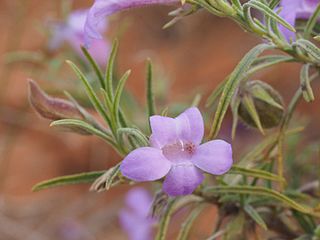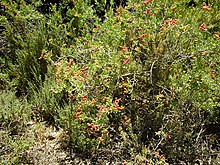
Santalum acuminatum, the desert quandong, is a hemiparasitic plant in the sandalwood family, Santalaceae, which is widely dispersed throughout the central deserts and southern areas of Australia. The species, especially its edible fruit, is also commonly referred to as quandong or native peach. The use of the fruit as an exotic flavouring, one of the best known bush tucker, has led to the attempted domestication of the species.

Eremophila is a genus of more than 270 species of plants in the figwort family, Scrophulariaceae all of which are endemic to mainland Australia. Some species have common names including emu bush, poverty bush or fuchsia bush, reflecting the belief that emus eat the fruit, their arid environment or a superficial resemblance to the flowers of plants in the genus Fuchsia. Eremophilas are widespread in the arid areas of Australia, especially Western Australia and range in size from low-growing shrubs to small trees. The petals are joined, at least at their bases, into a tube with the upper petals different in size and shape from the lower ones.
Mead Island is an uninhabited sand island located about 200 metres from Dirk Hartog Island in the Shark Bay World Heritage Site in Western Australia, and joined to that island at low tide. It has an area of about 800 square metres, and an elevation of two metres (7 ft).
Eagle Island is about 200 metres from Eagle Bluff on the Peron Peninsula in Shark Bay World Heritage Site in the Gascoyne region of Western Australia.

Carissa spinarum, the conkerberry or bush plum, is a large shrub of the dogbane family (Apocynaceae), widely distributed in tropical regions of Africa, Southern Asia, Australia, and various islands of the Indian Ocean. It is most well known in Australia, where it is also called currant bush or, more ambiguously, native currant or even black currant. It is, however, neither closely related to plums (Prunus) nor to true currants (Ribes), which belong to entirely different lineages of eudicots. In India, it is also called wild karanda/wild karavanda, referring to the related karanda. Carissa spinarum is often discussed under its many obsolete synonyms.

Mallee are trees or shrubs, mainly certain species of eucalypts, which grow with multiple stems springing from an underground lignotuber, usually to a height of no more than 10 m (33 ft). The term is widely used for trees with this growth habit across southern Australia, in the states of Western Australia, South Australia, New South Wales and Victoria, and has given rise to other uses of the term, including the ecosystems where such trees predominate, specific geographic areas within some of the states and as part of various species' names.

Eremophila longifolia, known by a range of common names including berrigan, is a flowering plant in the figwort family, Scrophulariaceae and is endemic to Australia. It is a shrub or small tree with weeping branches, long, narrow leaves and brick-red or pink flowers and is found in all Australian mainland states and the Northern Territory.

Nitraria, known as the nitre bushes, is a genus of flowering plants in the family Nitrariaceae, native to Africa, Europe, Asia, Russia and Australia.

Enchylaena tomentosa, commonly known as barrier saltbush or ruby saltbush, is a small native shrub of Australia.
Shag Rock is a small rocky island in the Wallabi Group of the Houtman Abrolhos.

Nitraria retusa, commonly known as Nitre bush, is a salt-tolerant and drought-resistant shrub in the family Nitrariaceae. It can grow to heights of 2.5 metres, although it seldom exceeds more than 1 m in height. It produces small white/green coloured flowers and small edible red fruit. The plant is native to desert areas of northern Africa, where it grows in primary succession on barren sand dunes, and in areas with high salinities such as salt marshes.
The Wemba Wemba language is an extinct Aboriginal Australian language once spoken along the Murray River and its tributaries in North Western Victoria and South Central New South Wales.

Eremophila sturtii, commonly known as turpentine bush, is a shrub endemic to Australia. Aboriginal people give it names including munyunpa and watara. A medium to large shrub, it is often multi-stemmed and has narrow leaves and lilac-coloured to pale mauve flowers. It is widespread and common in the drier parts of Australia and occurs in all mainland states, although it is endangered in Victoria. It is sometimes regarded as a weed, partly because of its ability to reproduce vegetatively.
Ferries McDonald Conservation Park is a protected area in the Australian state of South Australia located in the gazetted locality of Monarto South about 10 kilometres (6.2 mi) south-west of Murray Bridge. It covers an area of 845 hectares and provides a habitat for a range of native and endangered species. It is one of a number of protected patches of remnant mallee bushland within the region. Conservation organisations are now attempting to restore and connect these patches of the fragmented Murray plains in an attempt to heighten the prospects of various rare and endangered species.
Cap Island Conservation Park is a protected area in the Australian state of South Australia located about 7.5 kilometres (4.7 mi) offshore, west of Mount Misery, Eyre Peninsula. The park covers Cap Island's 8ha surface. The island consists of a granite base and a calcarenite mantle; its margins steeply over-hanging and eroded. Typical vegetation is a low Nitre Bush shrubland. Cap Island Conservation Park was constituted by statute in 1972 to conserve a sea bird breeding area and Australian Sea-lion and New Zealand Fur-seal haul-out areas.
Baudin Rocks, also previously known as the Godfrey Islands, is a group of islets on the south east coast of in the Australian state of South Australia about 8.3 kilometres North-northwest of Robe. The islet group was discovered and named by Matthew Flinders in 1802 after Nicolas Baudin. The group has had protected area status since 1965 and since 1972, the group has been part of the Baudin Rocks Conservation Park.

Eremophila gilesii, commonly known Charleville turkey bush, green turkey bush, desert fuchsia and Giles emu bush is a flowering plant in the figwort family, Scrophulariaceae and is endemic to Australia. It is usually a low, spreading shrub with pinkish-lilac to purple flowers and is widespread in the Northern Territory and all mainland states except Victoria. It is considered a difficult agricultural weed in some parts of Queensland but is often used as a bush medicine by Aboriginal people.

.

Amyema bifurcata is an epiphytic, flowering, hemiparasitic plant of the family Loranthaceae native to Australia and found in Western Australia, the Northern Territory, Queensland and New South Wales.

The pale-rumped ctenotus or regal striped skink is a medium-sized species of skink with an arid distribution restricted to the Australian Mainland, which belongs to the largest group of reptiles in Australia, Ctentotus.













